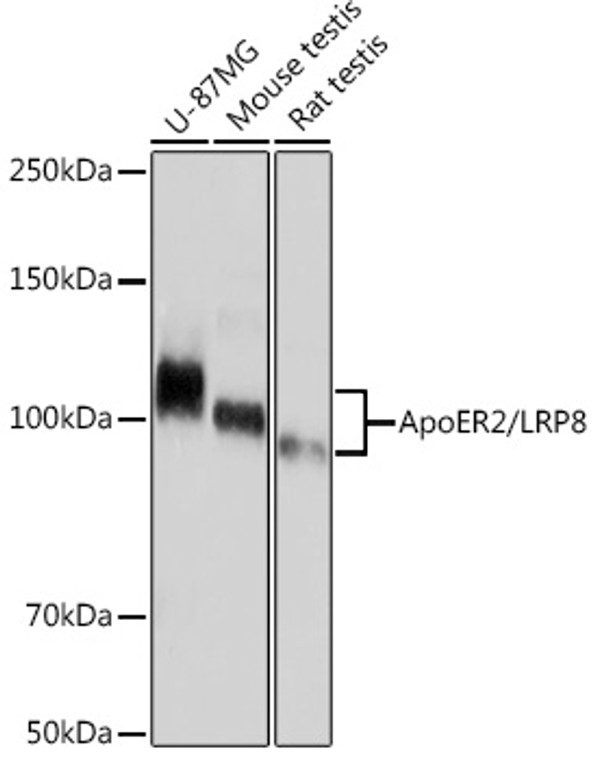| Host: |
Rabbit |
| Applications: |
WB |
| Reactivity: |
Human/Mouse/Rat |
| Note: |
STRICTLY FOR FURTHER SCIENTIFIC RESEARCH USE ONLY (RUO). MUST NOT TO BE USED IN DIAGNOSTIC OR THERAPEUTIC APPLICATIONS. |
| Short Description: |
Rabbit monoclonal antibody anti-ApoER2 (864-963) is suitable for use in Western Blot research applications. |
| Clonality: |
Monoclonal |
| Clone ID: |
S7MR |
| Conjugation: |
Unconjugated |
| Isotype: |
IgG |
| Formulation: |
PBS with 0.02% Sodium Azide, 0.05% BSA, 50% Glycerol, pH7.3. |
| Purification: |
Affinity purification |
| Dilution Range: |
WB 1:500-1:1000 |
| Storage Instruction: |
Store at-20°C for up to 1 year from the date of receipt, and avoid repeat freeze-thaw cycles. |
| Gene Symbol: |
LRP8 |
| Gene ID: |
7804 |
| Uniprot ID: |
LRP8_HUMAN |
| Immunogen Region: |
864-963 |
| Immunogen: |
A synthetic peptide corresponding to a sequence within amino acids 864-963 of human ApoER2/LRP8 (Q14114). |
| Immunogen Sequence: |
PVYRKTTEEEDEDELHIGRT AQIGHVYPAAISSFDRPLWA EPCLGETREPEDPAPALKEL FVLPGEPRSQLHQLPKNPLS ELPVVKSKRVALSLEDDGLP |
| Tissue Specificity | Expressed mainly in brain and placenta. Also expressed in platelets and megakaryocytic cells. Not expressed in the liver. |
| Post Translational Modifications | O-glycosylated. Some alternatively spliced isoforms lack the O-linked sugar domain. Undergoes sequential, furin and gamma-secretase dependent, proteolytic processing, resulting in the extracellular release of the entire ligand-binding domain as a soluble polypeptide and in the intracellular domain (ICD) release into the cytoplasm. The gamma-secretase-dependent proteolytical processing occurs after the bulk of the extracellular domain has been shed, in a furin-dependent manner, in alternatively spliced isoforms carrying the furin cleavage site. Hypoglycosylation (mainly hypo-O-glycosylation) leads to increased extracellular cleavage, which in turn results in accelerating release of the intracellular domain (ICD) by the gamma-secretase. The resulting receptor fragment is able to inhibit Reelin signaling and in particular the Reelin-induced DAB1 phosphorylation. Tyrosine phosphorylated upon apoE binding. Ubiquitinated by MYLIP leading to degradation. |
| Function | Cell surface receptor for Reelin (RELN) and apolipoprotein E (apoE)-containing ligands. LRP8 participates in transmitting the extracellular Reelin signal to intracellular signaling processes, by binding to DAB1 on its cytoplasmic tail. Reelin acts via both the VLDL receptor (VLDLR) and LRP8 to regulate DAB1 tyrosine phosphorylation and microtubule function in neurons. LRP8 has higher affinity for Reelin than VLDLR. LRP8 is thus a key component of the Reelin pathway which governs neuronal layering of the forebrain during embryonic brain development. Binds the endoplasmic reticulum resident receptor-associated protein (RAP). Binds dimers of beta 2-glycoprotein I and may be involved in the suppression of platelet aggregation in the vasculature. Highly expressed in the initial segment of the epididymis, where it affects the functional expression of clusterin and phospholipid hydroperoxide glutathione peroxidase (PHGPx), two proteins required for sperm maturation. May also function as an endocytic receptor. Not required for endocytic uptake of SEPP1 in the kidney which is mediated by LRP2. Together with its ligand, apolipoprotein E (apoE), may indirectly play a role in the suppression of the innate immune response by controlling the survival of myeloid-derived suppressor cells. (Microbial infection) Acts as a receptor for Semliki Forest virus. |
| Protein Name | Low-Density Lipoprotein Receptor-Related Protein 8Lrp-8Apolipoprotein E Receptor 2 |
| Database Links | Reactome: R-HSA-432142Reactome: R-HSA-975634 |
| Cellular Localisation | Cell MembraneSingle-Pass Type I Membrane ProteinSecretedIsoforms That Contain The Exon Coding For A Furin-Type Cleavage Site Are Proteolytically ProcessedLeading To A Secreted Receptor Fragment |
| Alternative Antibody Names | Anti-Low-Density Lipoprotein Receptor-Related Protein 8 antibodyAnti-Lrp-8 antibodyAnti-Apolipoprotein E Receptor 2 antibodyAnti-LRP8 antibodyAnti-APOER2 antibody |
Information sourced from Uniprot.org
12 months for antibodies. 6 months for ELISA Kits. Please see website T&Cs for further guidance








